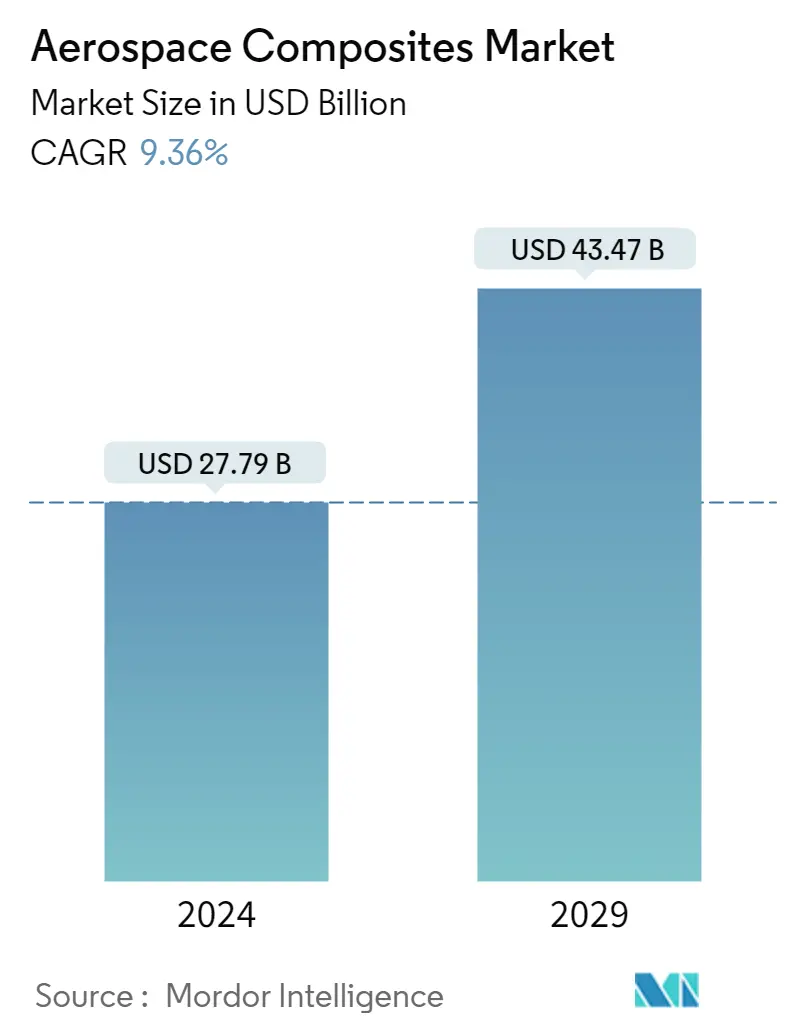Market Size of Aerospace Composites Industry

| Study Period | 2019 - 2029 |
| Market Size (2024) | USD 27.79 Billion |
| Market Size (2029) | USD 43.47 Billion |
| CAGR (2024 - 2029) | 9.36 % |
| Fastest Growing Market | Asia Pacific |
| Largest Market | North America |
Major Players.webp)
*Disclaimer: Major Players sorted in no particular order |
Aerospace Composites Market Analysis
The Aerospace Composites Market size is estimated at USD 27.79 billion in 2024, and is expected to reach USD 43.47 billion by 2029, growing at a CAGR of 9.36% during the forecast period (2024-2029).
The characteristics of composites, like temperature and chemical resistance, lightweight, high stiffness, dimensional stability, and flex performance, among others, made their use popular in various aerospace components and structural applications. Reduced maintenance, longer design life, fewer parts, and reduced tooling and assembly costs are some of the reasons that drive the aerospace composites market.
The substantial rise in passenger traffic and the imposition of new emission regulations led to a significant increase in demand for new-generation aircraft purchases over the last decade, before the pandemic. Aircraft manufacturers are developing new aircraft models in the commercial, military, and general aviation sectors, requiring newer engines with better performance and low weight. As a result, the emphasis on newer material technologies like composites is increasing.
Aerospace Composites Industry Segmentation
Aerospace composites are chosen for their ability to provide a combination of lightweight, high strength, corrosion resistance, and fatigue resistance. These characteristics make composites particularly suitable for applications where traditional materials like metals might be less efficient due to their weight or susceptibility to corrosion.
The aerospace composites market includes all applications of composites in military aircraft, commercial aircraft, general aviation aircraft, and spacecraft. Fiber type, application, and geography segment the aerospace composites market. By fiber type, the market is segmented into glass fiber, carbon fiber, ceramic fiber, and other fiber types. By application, the market is segmented into commercial aviation, military aviation, general aviation, and space. The report also covers the market sizes and forecasts for the aerospace composites market in major countries across different regions. For each segment, the market size is provided in terms of value (USD).
| Fiber Type | |
| Glass Fiber | |
| Carbon Fiber | |
| Ceramic Fiber | |
| Other Fiber Types |
| Application | |
| Commercial | |
| Military | |
| General Aviation | |
| Space |
| Geography | |||||||
| |||||||
| |||||||
| |||||||
| |||||||
|
Aerospace Composites Market Size Summary
The aerospace composites market is poised for significant growth, driven by the increasing demand for lightweight and high-performance materials in aircraft manufacturing. Composites are favored for their superior properties, such as temperature and chemical resistance, lightweight nature, and high stiffness, which contribute to reduced maintenance and longer design life. The market is experiencing a surge in demand due to the rise in passenger traffic and the need for new-generation aircraft that comply with stringent emission regulations. This has led to a focus on developing advanced aircraft models across commercial, military, and general aviation sectors, further propelling the adoption of composite materials. The commercial aircraft segment holds the largest market share, supported by the expansion of airline routes and the introduction of new airlines, alongside a growing air cargo market.
The Asia-Pacific region is emerging as a pivotal hub for the aerospace composites market, fueled by the rapid growth of civil aviation in countries like India and China. The region's increasing demand for air travel and military aviation, driven by geopolitical tensions and military spending, is contributing to the market's expansion. Major aerospace companies, including Airbus and Boeing, are delivering a significant portion of their aircraft to customers in this region, with a notable emphasis on engines utilizing composite materials. The market is semi-consolidated, with key players like Toray Industries, SGL Carbon, Hexcel Corporation, Solvay SA, and DuPont dominating the landscape. Strategic partnerships and investments in advanced composites for space applications are expected to create new opportunities and enhance market presence, as evidenced by recent collaborations and contracts in the industry.
Aerospace Composites Market Size - Table of Contents
-
1. MARKET DYNAMICS
-
1.1 Market Overview
-
1.2 Market Drivers
-
1.3 Market Restraints
-
1.4 Porter's Five Forces Analysis
-
1.4.1 Bargaining Power of Suppliers
-
1.4.2 Bargaining Power of Buyers/Consumers
-
1.4.3 Threat of New Entrants
-
1.4.4 Threat of Substitute Products
-
1.4.5 Intensity of Competitive Rivalry
-
-
-
2. MARKET SEGMENTATION
-
2.1 Fiber Type
-
2.1.1 Glass Fiber
-
2.1.2 Carbon Fiber
-
2.1.3 Ceramic Fiber
-
2.1.4 Other Fiber Types
-
-
2.2 Application
-
2.2.1 Commercial
-
2.2.2 Military
-
2.2.3 General Aviation
-
2.2.4 Space
-
-
2.3 Geography
-
2.3.1 North America
-
2.3.1.1 United States
-
2.3.1.2 Canada
-
-
2.3.2 Europe
-
2.3.2.1 United Kingdom
-
2.3.2.2 France
-
2.3.2.3 Germany
-
2.3.2.4 Rest of Europe
-
-
2.3.3 Asia-Pacific
-
2.3.3.1 China
-
2.3.3.2 Japan
-
2.3.3.3 India
-
2.3.3.4 South Korea
-
2.3.3.5 Rest of Asia-Pacific
-
-
2.3.4 Latin America
-
2.3.4.1 Brazil
-
2.3.4.2 Rest of Latin America
-
-
2.3.5 Middle East and Africa
-
2.3.5.1 South Africa
-
2.3.5.2 United Arab Emirates
-
2.3.5.3 Rest of Middle East and Africa
-
-
-
Aerospace Composites Market Size FAQs
How big is the Aerospace Composites Market?
The Aerospace Composites Market size is expected to reach USD 27.79 billion in 2024 and grow at a CAGR of 9.36% to reach USD 43.47 billion by 2029.
What is the current Aerospace Composites Market size?
In 2024, the Aerospace Composites Market size is expected to reach USD 27.79 billion.

